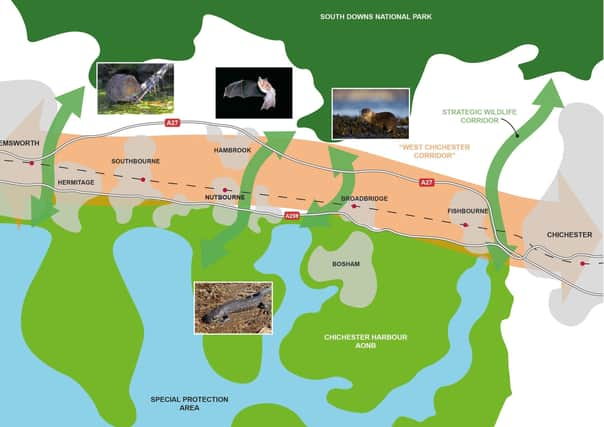Wildlife corridors a ‘critical link’ between Chichester Harbour and South Downs


While there has been much controversy surrounding Chichester District Council’s local plan review, policy S30 involving the creation of wildlife corridors has been seen as a ‘positive and revolutionary step’.
The Chichester district has a rich diversity of habitats with many internationally or nationally designated including ten European sites, 38 Sites of Special Scientific Interest (SSSI) and 130 local wildlife sites.
Advertisement
Hide AdAdvertisement
Hide AdHowever, the State of Nature report in 2019 said that, since 1980, more than one in seven wildlife species in the UK became extinct or threatened with extinction.
Campaigners feel there is an ongoing threat to much of our protected wildlife, those species protected by law as defined by Natural England, including otters, water voles, badgers, bats, dormice, toads, newts, wild birds, invertebrates and plants.
Jane Towers, a Chidham and Hambrook parish councillor, has been helping map the parish for wildlife, identifying the distinct ecological networks, local wildlife sites and priority habitats.
Last week she took a walking tour around Nutbourne, one of the three villages in the parish, looking for the often elusive wildlife living there.
Advertisement
Hide AdAdvertisement
Hide AdShe said: “In two hours looking in local fields we found plenty of evidence of water vole habitats with numerous species of flora and fauna. The many ancient oak trees clearly support bats with roosts visible.
“These habitats are essential for bats. With many residents having sited bat recorders in their gardens, we also know we have 14 types of bats here, seven of which are on the UK critically endangered redlist.
“We think it’s essential to protect the habitats of all the 291 species we have in the parish, much of which is already established in the proposed Nutbourne wildlife corridor. It is not only protected species that bring joy to residents. Deer are regularly sighted as they move from the South Downs National Park to Chichester Harbour AONB.”
To establish the scope of biodiversity, the parish also contacted Sussex Biodiversity Records Centre.
Advertisement
Hide AdAdvertisement
Hide AdThey had 15,000 wildlife records for the parish showing nearly 300 protected and designated species, both living here and travelling north and south between the South Downs and Chichester Harbour.
The biodiversity report shows a wealth of wildlife, including hundreds of bats, birds, mammals, plants, reptiles and butterflies living in and moving through local fields.
The wildlife corridors are not just about giving animals undisturbed space to forage, feed and breed in a wider landscape, but also enabling them to move between sites, so they can maintain genetic diversity and give them the chance to adapt to changes in their surroundings.
However there are still challenges ahead with the wildlife corridors as it is felt they need backing up with much more robust legislation so they are protected from development in perpetuity.
Advertisement
Hide AdAdvertisement
Hide AdAndrew Kerry-Bedell, from Save Our Harbour Villages, said: “These corridors, many of which run through productive farmland, aren’t just about wildlife. Protecting agricultural land is all about UK food security too.
“The farming land around Nutbourne has been used for cereals and crops since the middle ages, and every bit of the farmland north of the A259 is classed as Grade 2, or very good for crops.
“As well as being key wildlife habitat, these fields provide tonnes of fresh local produce every year, including beans, beetroot, pumpkins, peas, rape, potatoes, oats, barley and wheat. We simply can’t afford to lose good farming land in these tough times.”